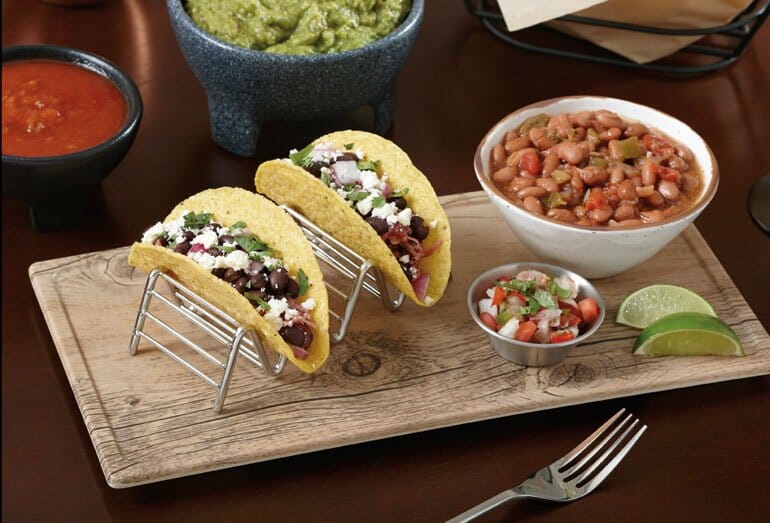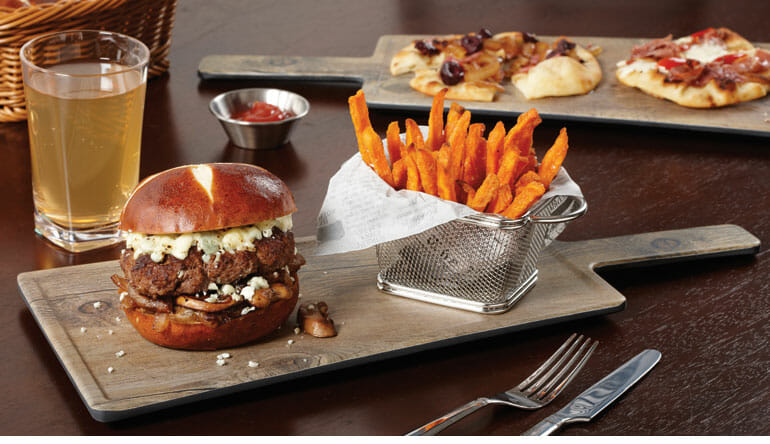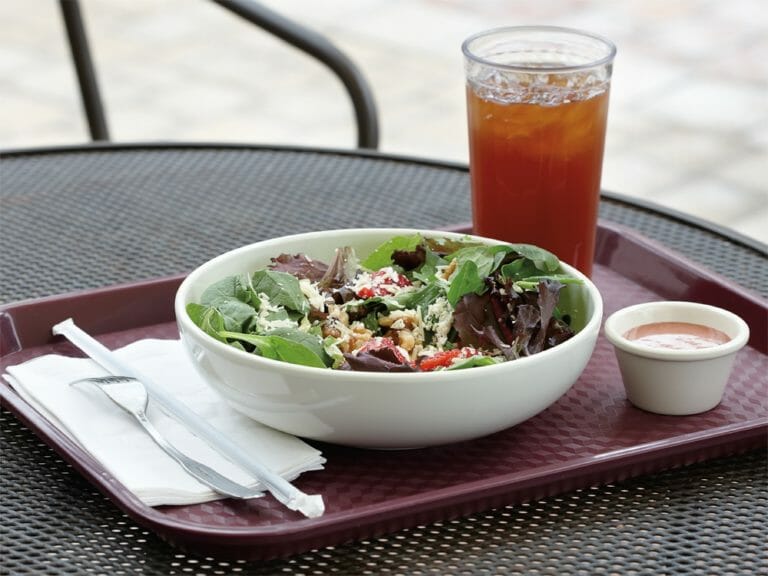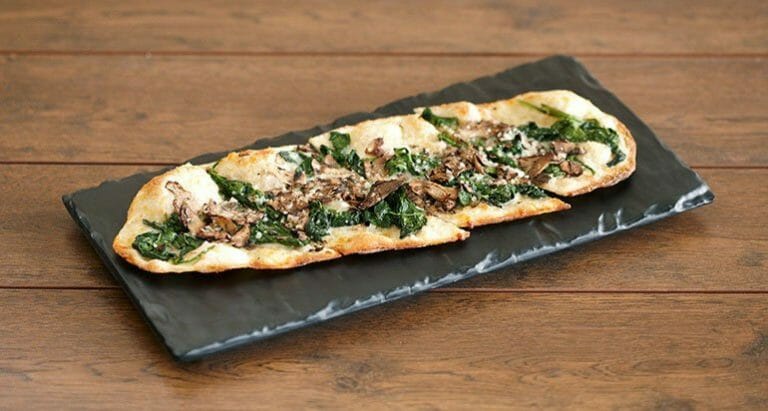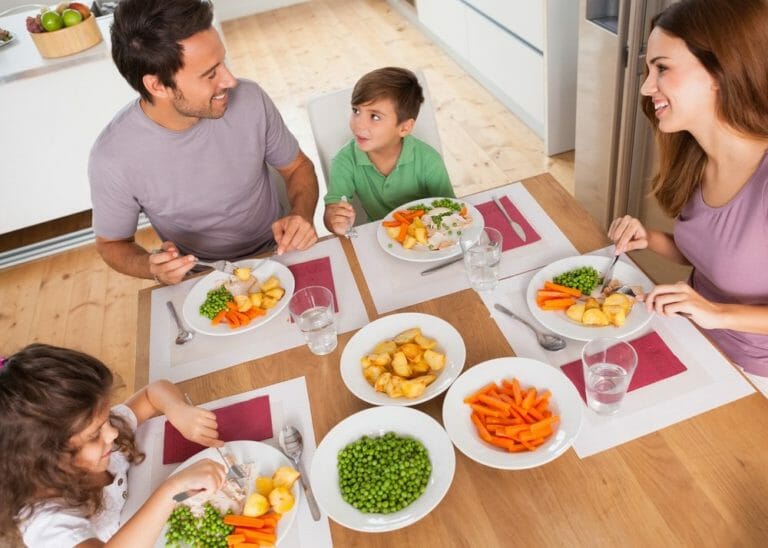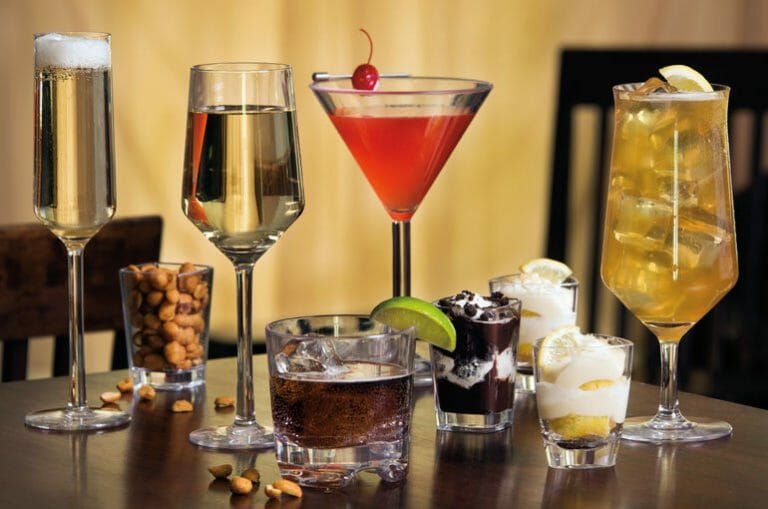Avoid these Common Food-Safe Surface Mistakes
Unless you’re a foodservice operator who’s mastered the art of levitating food, your food is going to come into contact with surfaces. A lot of them. Our food is constantly in contact with something at every point in its life cycle.
As a foodservice operator, your #1 priority is the safety of your guests and staff. Period. It doesn’t matter how delicious a dish is if it comes into contact with an unapproved surface resulting in illness or injury. Your guests count on your food safety knowledge every time they visit your establishment. And we want you to count on us at G.E.T. to light the way toward excellent tabletop execution, especially when it comes to food-safe surfaces.
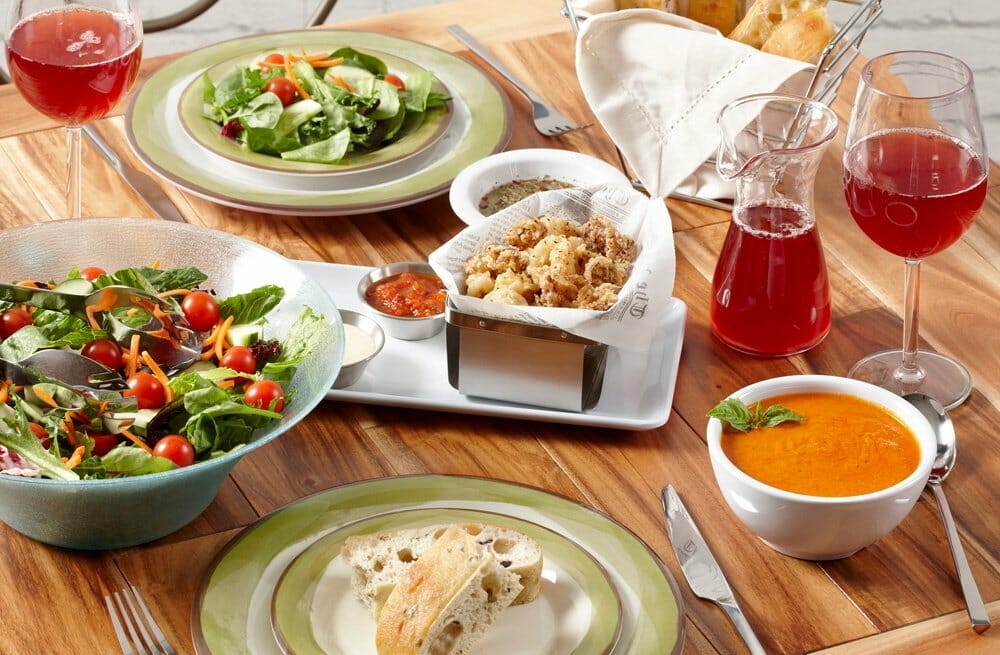
Pictured: common food-safe surfaces such as melamine, plastic, food-safe paper, and stainless steel
Common Food-Safe Surfaces
In any commercial kitchen, you can expect to find the same materials over and over again. Stainless steel, aluminum, ceramic, glass, melamine, and plastic take up the top spots for favorite kitchen materials.
Overall, these materials are:
- Smooth
- Non-porous
- Durable
- Dishwasher safe
- Lack 90° angles when designed for foodservice, reducing the opportunity for bacteria to form
An exception is ceramic, which is porous but often coated or glazed to seal pores.
We bring up these qualities because they’re the foundation for a material’s eligibility for certification from the National Sanitation Foundation, or NSF, because they all contribute to a material’s ability to be sanitized. What’s NSF certification, and why does it matter? We’re glad you asked.
NSF Certification for Food Contact Surfaces
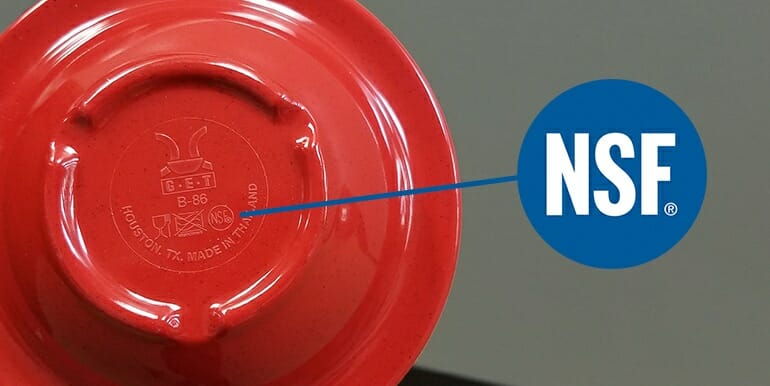
NSF was founded in 1944 with the goal of improving public health. Since then, they’ve become the industry standard for certifying foodservice products as safe for their intended use. For example, the intended use of melamine dinnerware is to serve food, not to cook with. So melamine can be NSF-certified for serving food, but not for cooking.
The qualities bulleted above are the major areas NSF considers for product certification review. They also take into account components in coatings, glazes, dyes, and pigments.
NSF certification is important for a few reasons:
- Bridge the gap between foreign (where many foodservice products come from) and domestic regulations, ensuring these products meet the highest standards in the US and Europe
- They regularly meet with the World Health Organization (WHO) and other regulatory agencies to stay up to date
- Annual recertification
- Manufacturing processes and facilities must also pass review as a routine part of certification
- Unannounced factory inspections
We’re just scratching the surface here, so if you’re interested in learning more about NSF certification, we recommend, âWhy NSF Certification Is the Most Important Foodservice Credential You’ve Never Heard Of.â
Seeking out NSF-certified products is about as food safe as you can get. However, NSF doesn’t certify all materials, which brings us to our next point.
Embrace Faux Materials
Wood intended for use as a cutting board can pass the NSF review process. Wood will never pass NSF review for use as dinnerware because it’s too porous. This is where âintended useâ is key.
Wood can be NSF-certified for use as a cutting board because ingredients are only momentarily in contact with the surface before they’re moved for further prepping. But serving a course on a wooden plate would keep the food in contact with the surface for too long, allowing food particles to seep into the grain. The result would be a piece of dinnerware that’s difficult to sanitize effectively.
However, that hasn’t stopped some operators from using wood for service. And we get it. Wood is beautiful. It can make a charcuterie board sing. It can add a rustic touch to a salad bowl. But it can’t be NSF-certified for serving food.
The good news here is that due to the popularity of natural materials’ aesthetics like wood, slate, marble, etc., that aren’t usually food-safe surfaces, the market is providing plenty of food-safe faux options. For example, the pictured faux wood board is made from NSF-certified melamine. It looks like the real thing, but it’s a certified food-safe material that’s less heavy and more durable than wood, and dishwasher-safe.
Explore the possibilities of food-safe faux materials and you can craft the look you want while knowing your guests are safe. If you’re not sure about whether a material is okay to use for food contact, reach out to NSF and they’ll point you in the right direction.
Now let’s explore the interesting, nuanced qualities of a wood derivative: paper.
Food-Safe Paper is Safe When it’s Used Properly
Food-safe paper represents one of the most widely used materials for serving food. From sandwich wraps to basket liners to paperboard cones, food-safe paper provides a barrier between food and either the material it’s served on or your guests’ hands.
Seems straightforward enough, right? Not so fast.
First, there are different kinds of food-safe paper designed for specific applications. Second, not all paper is safe for use with food.
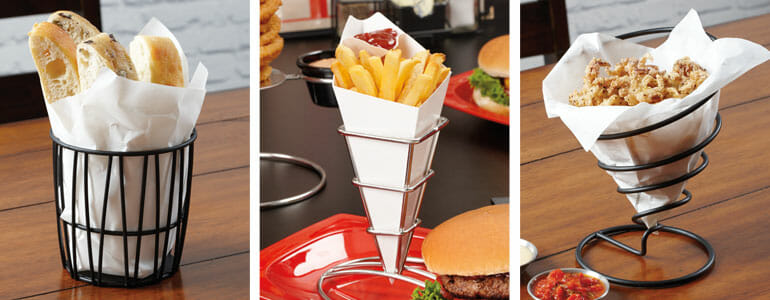
Pictured: various food-safe paper liners, wraps, and paperboard cones
Grease-Resistant vs. Waxed Food-Safe Paper
The two most popular kinds of food-safe paper are grease-resistant and waxed paper.
Grease-resistant paper has a food-safe coating either sprayed on it or worked into the fiber at the beginning of the manufacturing process. The coating keeps greasy food from seeping through the paper. Inkless white and brown versions of this paper are great for basket liners and sandwich wraps.
Some metal baskets with grid designs feature 90° angles where food can get stuck, which is one of the reasons why paper basket liners are prevalent.
Food-safe inks exist but are often cost-prohibitive. If you’re using inexpensive grease-resistant paper with ink on it, chances are it may not be food-safe ink.
Printed grease-resistant paper is perfectly fine to use for sandwich wraps or other applications where the ink stays on the outside and doesn’t touch the food.
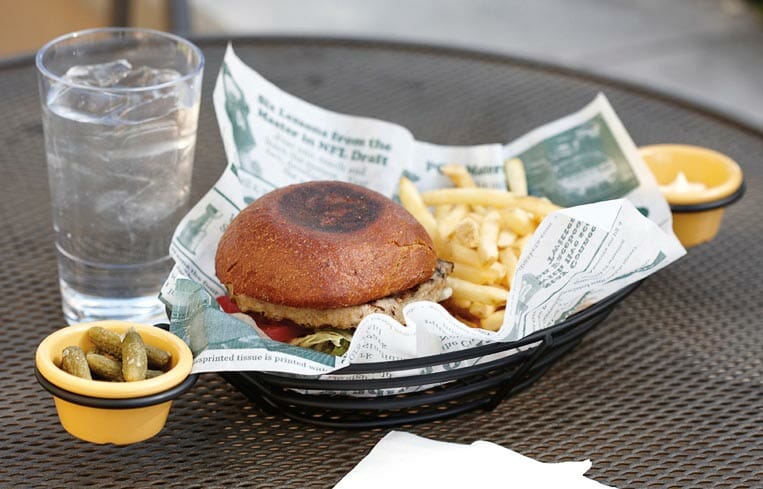
Pictured: newsprint themed paper with wax barrier between paper and ink for safe food contact
Where operators sometimes goof up is assuming that printed grease-resistant paper is also okay to use as a basket liner. But there’s no barrier between the toxic ink and the food. This is a common misuse of food-safe paper.
The only instances in which food and ink should be on the same side of printed grease-resistant paper is if the printing is restricted to the perimeter. Basket liners with designs on each corner are great examples of properly using printed grease-resistant food-safe paper.
We’ve personally seen red- or blue-and-white checkered grease-resistant paper used as a food contact surface to line baskets for appetizers, burgers, you name it.
Grease-resistant paper is often marketed correctly as a sandwich wrap as opposed to a basket liner. However, when operators make this mistake, often unintentionally, it’s because they don’t understand why sandwich wraps shouldn’t be used as basket liners. They see a less expensive option than waxed paper and mistakenly assume it’s a catchall food-safe paper. Unfortunately, grease-resistant paper doesn’t work that way.
Waxed paper, however, does. That’s because waxed food-safe paper has a barrier â food-safe wax â between ink and food. When using printed waxed food-safe paper, the ink and food can overlap wherever you like because the wax barrier keeps the ink from transferring to the food. Waxed food-safe paper with printed designs on it is an excellent choice for basket liners.
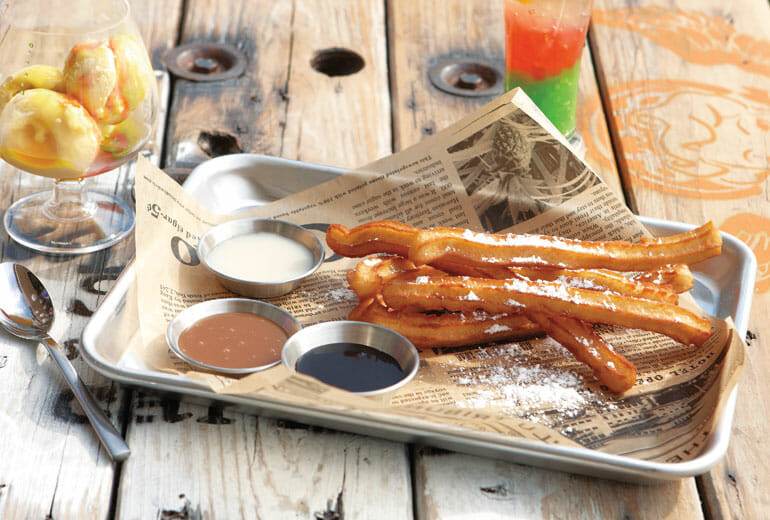 Pictured: creative presentation using vintage newsprint themed food-safe paper
Pictured: creative presentation using vintage newsprint themed food-safe paper
Newspaper is Not a Food-Safe Paper
Serving food on newspaper is not a food-safe application. During a certain point in time, newspaper was commonly used for wrapping and serving food. Thanks to better technology and understanding of food safety, this eventually morphed into the kinds of food-safe paper we use today.
As with the two types of food-safe paper above, the ink is the primary issue. Newspaper ink is not intended for foodservice. Additionally, no barrier exists between the ink and anything else that comes into contact with it. This is evident if you’ve ever handled a lot of newspaper because the ink transfers to your hands. The same thing happens, but in your mouth, when food is served on it.
Further, neither the paper on which newspapers are printed, nor the facilities where they’re produced, nor the stands where they’re sold are optimized for food safety. That means nearly every surface a newspaper comes into contact with is not food-safe.
If you like the vintage look of newsprint â and plenty of folks do â just look for food-safe paper with a newsprint theme, like this one. Then you can get the look you want with the assurance that you’re serving on a surface that’s safe for food contact.
We know the majority of foodservice operators truly care about the safety of their guests. But we also know that sometimes excitement over a new idea, like using wood as dinnerware, can occasionally overshadow the more practical side of operations. We hope this has been insightful, and maybe even answered some questions you didn’t know you had. If you’d like to read more about different use cases for food-safe paper, we’ve got just what you need in, âBest Food-Safe Paper for Sandwich Wraps & Basket Liners.â
Have you seen some far-fetched dinnerware materials in your day? We’d love to hear about them in the comments below!
{{cta(‘8d97949d-5da3-4d20-be7d-c81134328a61’)}}

